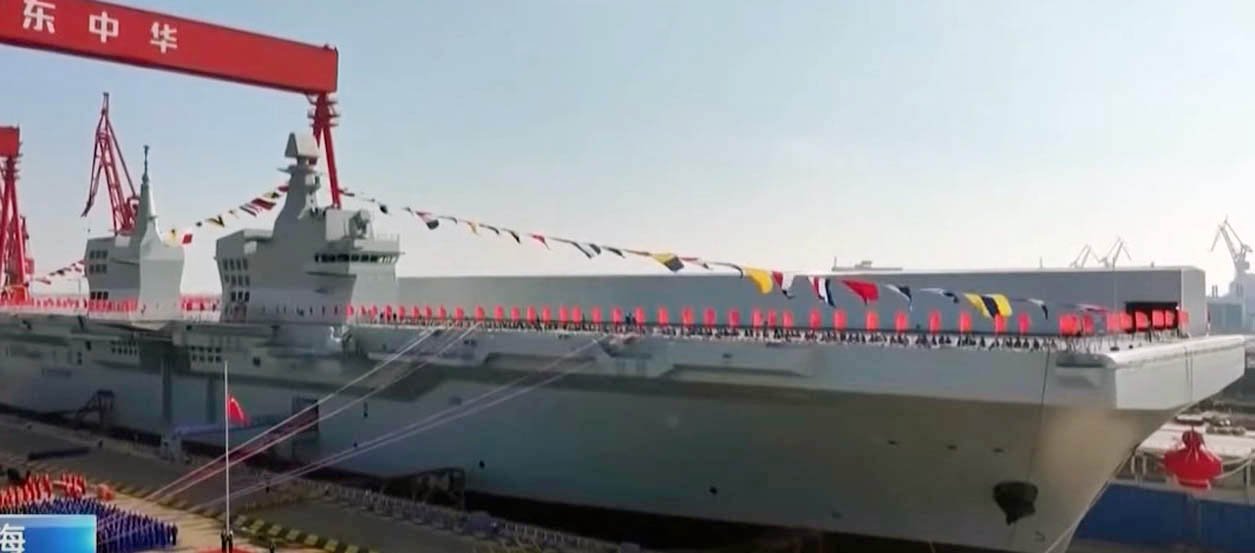December 28, 2024 – China has revealed its biggest and most progressive land and/or water capable attack transport, the Sichuan, denoting a notable improvement in the country’s maritime capabilities. The send off of this Kind 076-class landing helicopter moor at the Hudong-Zhonghua shipyard in Shanghai shows China’s desire to grow its oceanic reach and increment its tactical presence all around the world.
A Technological Leap Forward
The Sichuan is no usual land and/or water capable attack transport. With an uprooting of approximately 40,000 tons, it traverses the hole between a normal helicopter transporter and a light plane carrying warship. Outfitted with state of the art electromagnetic sling innovation and arrestor wires, the vessel can send off and return fixed-wing airplane — a component previously saved for standard plane carrying warships.
This development allows the Sichuan to send an extensive variety of flight resources, including contender planes, robots, and helicopters. Reports infer that unmanned combat aerial vehicles (UCAVs) fit for accuracy strikes and observation tasks are among the boat’s arranged payloads. Also, the vessel’s deck configuration licenses concurrent air operations, extensively further developing war readiness.
Capabilities and Mission Scope
The Sichuan is designed to assist amphibious operations on a huge scale. It can transport hundreds of troops, armored vehicles, and heavy equipment, using onboard hovercraft and landing boats to deploy them to shore. Beyond its amphibious duty, the ship can offer air cover, intelligence, and logistical support in multi-domain operations.
The combination of stealth features, improved radar systems, and integrated command centers makes the ship a powerful force multiplier. It also contains substantial medical facilities, enabling its employment as a humanitarian relief vessel during natural disasters.
Strategic Implications
The presentation of the Sichuan comes amid escalating tensions in the Indo-Pacific area, particularly concerns Taiwan and the South China Sea. Analysts say the ship’s potential to project force far from China’s borders accords with Beijing’s strategic goals of defending its maritime rights and imposing authority in disputed zones.
The ship’s launch is particularly significant in the light of China’s “blue water” navy goals, intending to operate successfully in deep oceans. According to Defense News, this development underscores a growing emphasis on countering the U.S. and its allies, who maintain a strong naval presence in the region.
Reactions and Concerns
The world local area has responded with a mix of deference and caution. Military experts, including as resigned U.S. Naval force Chief of naval operations James Stavridis, feel that the Sichuan could move the overall influence in the Asia-Pacific. “This ship is not just a defensive asset; it’s an offensive weapon of deterrence,” he stated in a meeting with Financial Times.
Regional countries, particularly Japan and India, are closely monitoring China’s naval progress. Both countries have boosted up their defense budgets, especially the procurement of modern maritime equipment.
Looking Ahead
The Sichuan is set to undergo rigorous sea trials before being commissioned into the People’s Liberation Army Navy (PLAN). Once operational, it will likely join China’s growing fleet of modern warships, including the Fujian, a third-generation aircraft carrier commissioned earlier this year.
Experts expect that the introduction of the Sichuan could motivate other governments to create similar multipurpose vessels. However, the possibility for greater naval clashes in contested waters cannot be disregarded.
Human Angle: A Double-Edged Sword
While the Sichuan represents a technological accomplishment for China, it raises issues about the impact on regional stability. Civilian settlements in contested areas, such as the South China Sea, could suffer heightened threats from escalating military actions. Furthermore, the ship’s deployment might exacerbate the armaments competition among major powers, diverting resources away from important global challenges like climate change and poverty reduction.
Sources and References
- Defense News: China Unveils Amphibious Assault Ship That Can Launch Fighter Jets
- Financial Times: China Launches Amphibious Assault Ship Sichuan
- Associated Press: Amphibious Ship Launches in China
- Reuters: China Bolsters Naval Power
- Global Times: Sichuan to Revolutionize Amphibious Warfare
This significant milestone in China’s naval expansion is destined to have far-reaching ramifications, impacting geopolitics and military plans for years to come.

